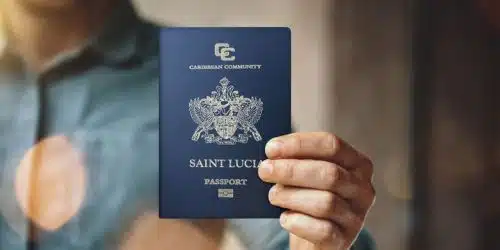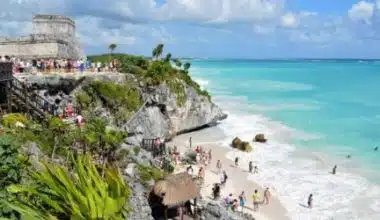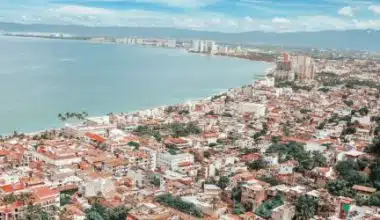There are places you can travel to with or without a passport. However, Saint Lucia, known for its stunning beaches, lush rainforests, and vibrant culture, needs some requirements for entry. Saint Lucia also boasts beautiful landmarks such as the Pitons, Sulphur Springs, and Pigeon Island. Additionally, the island is home to several luxury resorts and offers a range of accommodations for visitors. There are lots of features that make Saint Lucia a unique and captivating destination, offering a blend of natural beauty, cultural richness, and recreational opportunities. All foreign nationals visiting or entering St. Lucia are required to have a valid passport from their country. The passport should be valid for at least six months after the travel date. Read on to learn more about their travel requirements.
Do You Need A Passport To Go To St Lucia?
Yes, you need a passport to go to St. Lucia. All foreign nationals visiting or entering St. Lucia are required to have a valid passport from their country. The passport should be valid for at least six months after the travel date. This requirement applies to travelers of all ages, including children. Both US citizens and citizens of any other country will need a passport to travel to St. Lucia.
To go to St. Lucia, there are several requirements that you need to fulfill. These requirements may include the following:
#1. Valid Passport
A current passport is required for entry into St. Lucia. For the duration of your trip to St. Lucia, your passport must be valid. It is often suggested to have at least six more months of passport validity beyond your travel dates.
#2. Visa
To enter St. Lucia, you could require a tourist visa, depending on your nationality. Before traveling, it’s essential to confirm the country-specific visa requirements. Some nations and St. Lucia have visa waiver arrangements, enabling their residents to travel there for a set amount of time without needing a visa.
#3. Proof of a negative COVID-19 test
Travelers need to provide a negative COVID-19 PCR test result, taken within a specified timeframe before travel. The time frame and type of test required may vary. Always check to stay updated.
#4. Vaccination status
St. Lucia requires proof of COVID-19 vaccination as part of the entry requirements. The specific vaccines accepted and any related guidelines should be confirmed before travel.
#5. Travel Insurance
It is advised to have travel insurance that provides coverage for medical emergencies, trip cancellations, and other unforeseen events during your stay in St. Lucia. This can help protect you financially and provide assistance in case of emergencies.
#6. Return/Onward Ticket
When entering St. Lucia, you might be required to show proof of a return or onward ticket. This proves that you intend to leave the country within the time frame allowed for your stay. It can be a flight ticket or another type of reservation for travel that demonstrates your departure from St. Lucia.
#7. Proof of Sufficient Funds
You need to provide evidence that you have enough money to meet your expenses throughout your stay in St. Lucia. To provide proof of your financial resources, you can provide financial documents. Such as bank or credit card statements, or any other evidence of your ability to support yourself while you are in the country.
#8. Accommodation Information
Confirm your accommodation arrangements in St. Lucia before you travel. Immigration authorities ask for details of your place of stay, such as hotel reservations, rental agreements, or contact information for the person you will be staying with.
#9. Customs and Immigration Forms
You will be required to fill out immigration and customs documents when you arrive in St. Lucia. Basic details like your name, address, the duration of your visit, and the specifics of any things you are carrying into the nation are normally requested on these forms. These forms must be carefully filled out to guarantee a smooth entrance procedure.
Features of Saint Lucia
The features of Saint Lucia include its physical geography, government structure, population, language, currency, and major landmarks.
Here are some key features:
#1. Geographic Features
Saint Lucia is an island state located in the Caribbean Sea. It is the second largest of the Windward group in the Lesser Antilles. The island is approximately 27 miles long and has a maximum width of 14 miles. It is known for its stunning geographic features, including the Pitons, Rainforests and Mountains, Beaches, Volcanic features, rivers, and waterfalls.
#2. Climate
The northeastern trade winds have an influence on Saint Lucia’s tropical maritime climate. The average annual rainfall ranges from 51 inches on the coast to as much as 150 inches in mountainous areas. The temperature and rainfall can vary with elevation.
#3. Marine Life
Saint Lucia is home to a diverse array of marine life. Visitors can encounter dolphins, whales, sea turtles (including leatherback, hawksbill, and green sea turtles), and various fish species while snorkeling or diving in the surrounding waters.
#4. Cultural Heritage
African, European, and native Carib and Arawak peoples have all influenced Saint Lucia’s rich cultural heritage. The island’s history and culture are celebrated through various festivals, music, dance, and traditional cuisine.
#5. Wildlife
Saint Lucia is home to a wide range of wildlife species, in addition to marine life. These include uncommon reptiles like the St. Lucia whiptail lizard, as well as agouti, mongooses, opossums, bats, wild pigs, and a variety of other animals.
#6. Coral Reefs
Coral reefs that are vibrant and home to a wide variety of marine life surround Saint Lucia. Snorkeling and scuba diving enthusiasts can explore these underwater ecosystems and encounter colorful fish, coral formations, and other marine species.
#7. Sulphur Springs
Located in Soufrière, Saint Lucia, Sulphur Springs is the world’s only drive-in volcano. Visitors can observe bubbling hot springs, mud pools, and steam vents caused by geothermal activity. The sulfur Springs also offer mud baths believed to have therapeutic properties.
#8. Historical Sites
Saint Lucia has a rich history, and there are several historical sites to explore. Some notable sites include Pigeon Island National Landmark, Fort Rodney, Morne Fortune, and Anse La Raye.
#9. Government
Saint Lucia is a democratic constitutional monarchy, with Queen Elizabeth II as its Head of State. The Prime Minister, currently Allen Chastanet, serves as the head of government.
#10. Language and Currency
The official language of Saint Lucia is English, but many residents also speak Saint Lucian French Creole. The currency used in Saint Lucia is the Eastern Caribbean dollar (XCD).
Tips For Travelers While Visiting St. Lucia
Here are some travel tips for visiting St. Lucia:
#1. Drive On The Left Side Of The Road
In St. Lucia, driving is on the left side of the road. Be aware of this and follow the local traffic rules.
#2. Make Copies Of Important Documents
Making copies of key documents, like your passport, travel insurance, and any other identity or travel documents you might require, is usually a smart idea.
#3. Notify Financial Institutions
Before traveling, inform your financial institutions, such as banks and credit card companies, about your travel plans to avoid any issues with your accounts.
When using taxis in St. Lucia, make sure to only use authorized taxis to ensure your safety and avoid any scams or issues.
#5. Be Cautious With Cash
Avoid carrying large amounts of cash, especially in crowded areas. Use ATMs or credit cards for transactions whenever possible.
#6. Visit During The Right Season
The best time to visit St. Lucia is between May and June when the weather is pleasant and there are fewer crowds. Avoid visiting during hurricane season, which typically runs from June to November.
#7. Protect Yourself From The Sun
Sunburn prevention is essential because the sun in St. Lucia can be harsh. To protect yourself from damaging UV rays, apply sunscreen with a high SPF and dress in light, breathable clothing, a hat, and sunglasses.
#8. Stay Safe In The Water
If you plan on swimming or participating in water activities, be cautious of strong currents and undertows. It’s advisable to swim in designated areas with lifeguards present and always follow safety guidelines.
#9. Respect The Environment
St. Lucia is known for its pristine natural beauty. Help preserve the environment by avoiding littering, using reusable water bottles, and being mindful of your impact on the surroundings.
#10. Embrace The Local Cuisine
Caribbean cuisine is tasty and abundant in St. Lucia. Sample regional fare like jerk chicken, fish cakes, callaloo, and plantains. To taste the true flavors of the island, visit neighborhood eateries and street food stands.
Places For Tourists To Visit In Saint Lucia
There are several secure locations for tourists to visit in Saint Lucia. Here are a few examples:
#1. Rodney Bay
Rodney Bay is a popular tourist area in the north of Saint Lucia. It is known for its beautiful beaches, vibrant nightlife, and a variety of restaurants and shops. The area is conducive for tourists, with a visible police presence.
#2. Marigot Bay
Marigot Bay is a picturesque bay located on the west coast of Saint Lucia. It is a popular destination for yachts and offers stunning views and tranquil surroundings. The bay is generally safe, and visitors can enjoy the beach, water activities, and dining options without major safety concerns.
#3. Soufrière
Soufrière is a town located on the southwest coast of Saint Lucia. It is famous for its natural attractions, including the Sulphur Springs and the Pitons, which are UNESCO World Heritage sites. Soufrière is safe for tourists, but it is always advisable to take standard precautions and be aware of your surroundings.
#4. Pigeon Island
Pigeon Island is a historic landmark and national park in the north of Saint Lucia. It offers beautiful beaches, hiking trails, and panoramic views of the island.
#5. Cap Estate
Cap Estate is an upscale residential area located in the northern part of Saint Lucia. It is known for its luxury resorts, golf courses, and stunning views of the Caribbean Sea. The area has a low crime rate.
#6. Anse Chastanet and Anse Mamin
These two beautiful beaches are located near Soufrière and offer crystal-clear waters and pristine sands. The area is cool, and visitors can enjoy swimming, snorkeling, and sunbathing.
#7. Castries
Castries is the capital city of Saint Lucia and serves as the main port of entry for cruise ships. While it is a bustling city, certain areas, such as Derek Walcott Square, the Cathedral of the Immaculate Conception, and the Castries Market, are safe for tourists.
#8. Morne Fortune
Morne Fortune is a historic hill located near Castries. It offers panoramic views of the city and the surrounding area. It is a serene area, and visitors can explore historic sites, such as the Government House and the Saint Lucia National Archives.
#9. Gros Islet
Gros Islet is a town located in the northern part of Saint Lucia. It is known for its Friday night street party, where locals and tourists come together to enjoy music, food, and dancing.
#10. Mamiku Gardens
Located in the southeastern part of the island, Mamiku Gardens is a botanical garden that offers a serene and peaceful environment. Visitors can explore the lush greenery, and colorful flowers, and learn about the local flora. It is considered safe for tourists.
Do I Need A Visa To Go To St. Lucia?
No, you do not need a visa to go to St. Lucia if you are a citizen of certain countries, including the United States, Canada, the United Kingdom, and Australia. Visitors from these countries are allowed to enter St. Lucia without a visa for a specified period of time. A valid passport with at least six months of validity beyond your date of country exit and one blank visa page is required.
What Documents Do I Need To Enter St. Lucia?
To enter St. Lucia, you will need a valid passport with at least six months of validity, and a visa (if applicable), depending on your nationality. Additionally, due to COVID-19, you must complete a digital travel registration form and provide proof of COVID-19 vaccination.
Which Countries Is St. Lucia Visa-Free To?
St. Lucia passport holders enjoy visa-free access to more than 146 countries. Some common visa-free destinations for St. Lucia passport holders include the Schengen states, the United Kingdom, Hong Kong, Singapore, Andorra, Antigua and Barbuda, Argentina, Aruba, Austria, the Bahamas, Barbados, Belize, Bolivia, Ecuador, Egypt, and many others. It is significant to remember that access without a visa can vary and may be subject to particular restrictions.
What Country Owns St. Lucia?
St. Lucia was formerly a British colony, but it gained independence from the United Kingdom on February 22, 1979. Since then, it has been a sovereign country and is no longer owned by any other nation. St. Lucia is now a democratic country with its own government and is a member of the Commonwealth, an organization of countries that work together and share common values.
What Currency Is St. Lucia?
The currency of St. Lucia is the Eastern Caribbean Dollar (EC$). It is the official currency and is widely accepted throughout the island. While the Eastern Caribbean Dollar is the primary currency used in St. Lucia, US dollars are also widely accepted at many establishments. Visitors can exchange currency at the airport or banks on the island.
What Islands Do Not Require A Passport?
Several islands do not require a passport for U.S. citizens, including the U.S. Virgin Islands, Puerto Rico, Guam, the Northern Mariana Islands, and American Samoa. These islands are either U.S. territories or commonwealths, and U.S. citizens can travel to them without a passport.
Conclusion
Saint Lucia is an island state located in the Caribbean Sea and U.S. citizens are required to present a valid U.S. passport when traveling to Saint Lucia. Both air travel and travel by privately owned seagoing vessels are subject to this rule. It is advised that you travel with a passport that is valid for the entire time you will be in Saint Lucia. Other Western Hemisphere Travel Initiative (WHTI)-compliant documents, however, might be acceptable in some particular situations for travelers arriving by ship. These locations offer beautiful beaches, historic sites, stunning views, and various activities. While generally safe, it is still advisable to use caution, pay attention to your surroundings, and adhere to accepted safety procedures. Always be sure to heed any local warnings, stay off the streets after dark, and utilize safe transportation wherever possible.
- DO YOU NEED A PASSPORT FOR ST. THOMAS?
- DO YOU NEED A PASSPORT TO GO TO HAWAII?
- PLACES YOU CAN GO WITHOUT A PASSPORT IN 2023
- DO YOU NEED PASSPORT TO GO TO JAMAICA? Jamaica Travel Requirements
- DO YOU NEED A PASSPORT TO GO TO ARUBA? Aruba Travel Requirements






